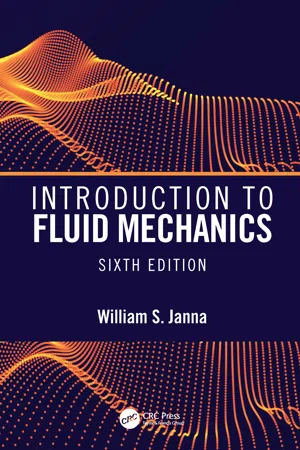Dimensional Equation
A dimensional equation is an equation that expresses the relationship between physical quantities in terms of their dimensions. It helps in understanding the fundamental properties and behavior of the quantities involved. By analyzing the dimensions of different physical quantities, dimensional equations can be used to derive new equations and verify the consistency of mathematical expressions in engineering and technology.
7 Key excerpts on "Dimensional Equation"
- Peter N. Kugler, Michael T. Turvey(Authors)
- 2015(Publication Date)
- Routledge(Publisher)
...Formal study of dimensional structure of these variables and equations is the subject of dimensional analysis (see Bridgman, 1922; Duncan, 1953; Kline, 1965; Langhaar, 1967; Rosen, 1978). Dimensional analysis provides a methodology for deriving an estimate of the form of an equation describing a physical process with a limited amount of knowledge about the actual quantitative details of the process. The only knowledge required is an identification of the dimensionality associated with the physical quantities and constants involved. For example, suppose the goal is to describe a physical process that depends on a certain number of physical quantities, or observables, then the law(s) governing the process must be expressible as some functional relation between the observables that are involved in it; that is, it must be of the form ϕ(x 1,x 2,. . . ,x n) = 0, (D.1) where the x i terms are the observables in question. This relation is called the equation of state of the process. D.3. Fundamemtal and Derived Dimensions The modern formulation of equation of states from dimensional considerations came from Fourier in 1822. He emphasized that the measurable quantities appearing in the mathematical representation of physical laws usually are not pure numbers; most of them have associated dimensions, such as velocity (length/time), momentum (Mass x length/time), force (mass x length/time 2). These can be expressed in terms of a smaller set of fundamental dimensions, which he took to be mass M, length L and time T. That is, every quantity x i of the equation of state has a dimension that can be expressed as a monomial of the fundamental ones: or, more generally, where each dimension, fundamental or derived, has a scale of units specified by the measurement situation. Magnitudes of different dimensions or units cannot be combined arbitrarily; they may be multiplied but they cannot be added...
- eBook - ePub
Dimensional Analysis
Practical Guides in Chemical Engineering
- Jonathan Worstell(Author)
- 2014(Publication Date)
- Butterworth-Heinemann(Publisher)
...We use the concept of dimensional homogeneity as a check on our algebraic manipulations. If a physical equation involves apples and we finish with “orpels,” then we know we have made an incorrect algebraic manipulation in our study. We also use Dimensional Analysis to develop self-consistent systems of units and to establish the conversion factors between those systems of units. As mentioned several times previously, aeronautical, civil, and mechanical engineers have used Dimensional Analysis quite successfully to obtain functional solutions to problems too complex for derivation of an analytic solution. The problems these engineering disciplines have solved using Dimensional Analysis involve the smallest possible set of fundamental dimensions and a small number of variables. Some heat transfer problems have been resolved using Dimensional Analysis. Fewer such solutions exist because they involve a more complex set of fundamental dimensions and a larger number of variables. Chemical processes are so complex that few attempts have been made to use Dimensional Analysis to analyze them. This situation will change in light of free-for-use matrix calculators on the Internet. Once we have a functional solution developed from Dimensional Analysis, we can use it to gain physical insight about the problem. For example, using a functional solution, we can generate experimental data identifying the controlling regimes of the mechanism or process. Dimensional Analysis provides us with a tool for designing experimental programs. By grouping dimensional variables into dimensionless parameters, we can reduce the number of independent variables, thereby reducing the number of experiments required to define a mechanism or process. Using dimensionless parameters also allows us to succinctly present the results of a given experimental program. Lastly, Dimensional Analysis provides a firm, logical foundation for the theory of models...
- eBook - ePub
Adiabatic Fixed-Bed Reactors
Practical Guides in Chemical Engineering
- Jonathan Worstell(Author)
- 2014(Publication Date)
- Butterworth-Heinemann(Publisher)
...They contain physical content because physical magnitudes arise from physical quantities, which in turn arise from our perceptions. Therefore, when we write a physical equation, we are, in essence, writing an equation that balances physical quantities α [Ψ] through the use of an equality sign. Thus, we arrive at the first “axiom” of dimensional analysis. Axiom 1 The numerical equality of a physical equation exists only when the physical magnitudes of that particular physical equation are similar, i.e., have the same units, which means the dimensions of the underlying physical quantities α [Ψ] are similar. 1 In other words, a valid physical equation is dimensionally homogeneous, i.e., all its terms have the same dimensions and units. All engineers and scientists learn this axiom upon their introduction to the study of Nature. We are told upon writing and solving our first physical equation that the individual terms of the given physical equation must have the same dimensions, i.e., units. We are also told that the dimensions and units of our calculated result must agree with the dimensions and units of the individual terms of the physical equation. For example, consider the physical equation W = X – Y + Z We can only calculate W if X, Y, and Z have the same dimensions and units. If X, Y, and Z each represent a physical magnitude of apples, then we can add and subtract them to obtain W, which will be a physical magnitude of apples. If X and Z have apple dimension and Y has orange dimension, then the above expression ceases to be a physical equation; it becomes meaningless from an engineering or scientific viewpoint. Nonhomogeneous expressions do not contain physical information, thus they are not physical equations...
- eBook - ePub
- Dov M. Gabbay, Paul Thagard, John Woods(Authors)
- 2011(Publication Date)
- North Holland(Publisher)
...Only knowledge of the relevant variables and their dimensional representation is required. 9 Although dimensional analysis is now used much less in chemical engineering than it was a few decades ago, 10 it is of interest because it involves a large number of reticulated models or ceteris paribus assumptions from the most “fundamental” to the most “applied” kinds. Moreover, though the number of models for which numerical solutions can be given of the governing equations under the prevailing boundary conditions has increased substantially, this doesn't mean that dimensionless numbers are disappearing from chemical engineering science and practice. In fact, new dimensionless numbers are still being added. 11 9 This section and the next is a slightly revised version of van Brakel [2000, § 7.2], where more references to the original literature can be found. 10 For a comprehensive inventory of dimensional analysis applications in chemical engineering see Dobre and Sanchez Marcano [2007]. For applications in other disciplines see [Palacios, 1964] and [Sedov, 1959]. 11 Nowadays one may find proposals for dimensionless number correlations which are valid for just one type of equipment (i.e. a particular design for a particular unit operation). The method of dimensional analysis has its origin in the principle of similitude already referred to by Newton. Fourier was the first to apply the geometrical concept of dimension to physical quantities. Maxwell expressed the requirement of dimensional homogeneity more precisely. Lord Rayleigh made extensive use of the method of dimensional analysis. Between 1890 and 1920 the “method of dimension” or the “procedure of dimensional analysis” was further developed. In its final form it can be summarised as follows [ Bridgman, 1922 ]. Using previous experience, decide on the general nature of the problem, including a judgement about which systems may be considered as similar in the relevant sense (see previous section)...
- eBook - ePub
- Keith J. Moss(Author)
- 2015(Publication Date)
- Routledge(Publisher)
...Example A1.4 is another case in point. AI.3 Appendix closure You have now been introduced to the dimensions of terms in common use and undertaken one of the applications to which dimensional analysis can be put. Clearly it is easier to check the form of an equation by using the units of the terms within it as shown in the Introduction A1.1, rather than by using the dimensions of the terms. However, it is important to persevere with using the dimensions of terms since they are used exclusively in Appendix 2 and they cross the boundaries of different systems of measurement. This chapter has sought to illustrate the way the dimensions of terms are expressed and provides a grounding for Appendix 2, which is where dimensional analysis has a major role in establishing the form of an equation relating to a number of variables and in assisting the analysis of experimental work....
- eBook - ePub
- William S. Janna(Author)
- 2020(Publication Date)
- CRC Press(Publisher)
...Measurements on the model can then be scaled up to predict performance of the prototype even though the prototype has not been built. Clearly, the cost is considerably less. Modeling wind flow past a building, for example, is an economical way of finding the effect of a hurricane on the structure. Thus, modeling problems have many useful applications. In this chapter, we will see how dimensionless ratios are used in modeling problems. 4.1 DIMENSIONAL HOMOGENEITY AND ANALYSIS An equation must be dimensionally homogeneous. That is, all terms in the equation must have the same dimensions or units. To compare dimensions of various terms within an equation, it is convenient to first convert the dimensions into fundamental units. Suppose we are working within the British gravitational system, in which force (F), length (L), and time (T) are considered fundamental. Mass (M) is a derived unit defined as M = F · T 2 / L. Consider, for example, the Bernoulli equation, derived in Chapter 3 : p ρ + V 2 2 + g z = a constant If we use the generalized notation, the dimensions of each term become p ρ = F L 2 L 3 M = F L 2 L 3 L F ⋅ T 2 = L 2 T 2 V 2 2 = L 2 T 2 g z = L T 2 L = L 2 T 2 Thus, each term has dimensions of L 2 / T 2 in a system in which F, L, and T dimensions are considered fundamental (British gravitational system). On the other hand we could reformulate the dimensions of the Bernoulli equation in the system in which only mass (M), length (L), and time (T) are fundamental (SI system). Force is a derived unit defined as F = M · L / T 2. Evaluating the Bernoulli equation in this system, we get p ρ = M ⋅ L T 2 1 L 2 L 3 M = L 2 T 2 V 2 2 = L 2 T 2 g z = L T 2 L = L 2 T 2 In Chapter 1, we discussed the English engineering system, in which force, mass, length, and time are considered fundamental. In this system, equations are often written with a conversion factor because mass and force are both considered fundamental...
- eBook - ePub
- Ken Morling, Stéphane Danjou(Authors)
- 2022(Publication Date)
- Routledge(Publisher)
...Chapter 7 Dimensioning DOI: 10.1201/9781003001386-7 7.1 INTRODUCTION In contrast to pictorial representations in user manuals, spare part catalogues and assembly instructions, an engineering drawing is not an illustration. An engineering drawing, or technical drawing, differs from a technical illustration in that it is strongly regularised by standards and represents a detailed specification of the size and shape of a single part or of an assembly. The subjects of interest are the dimensions and associated tolerances. When an engineering drawing is made, dimensioning is of vital importance. All the dimensions necessary to manufacture a part must be on the drawing and they must be presented so that they can be easily read, easily found and not open to misinterpretation. A neat drawing can be spoilt by bad dimensioning. The principles for presentation of dimensions that apply to any kind of 2D engineering drawing is internationally standardised in ISO 129–1. National standards may differ from the given conventions. Figure 7.1 explains the structure of dimensions in engineering drawings. In general, dimensions consist of a dimension line, extension lines and a dimension value. This applies to linear dimensions and angular dimensions as well. An extension line is sometimes also referred to as a projection line and represents an extension of a feature outline or centre line. Extension lines indicate the starting and end point of a dimension. They are drawn as narrow continuous lines and extend from the outline to approximately 2 mm past the dimension line. While according to international standards the extension line shall touch the outline or feature to which it refers, Anglo-American standards require a visible gap between them...






